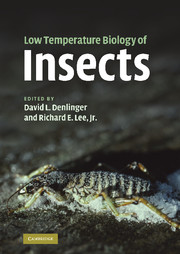14 - Implications of cold-tolerance for pest management
from PART III - PRACTICAL APPLICATIONS
Published online by Cambridge University Press: 04 May 2010
Summary
Introduction
In a global context “pest management” usually refers to the control of invertebrate organisms, the great majority of which are insects, with some important examples among the mites and nematodes. Also, whilst these pests are primarily associated with agricultural and horticultural crops and forestry, the impact of arthropod disease vectors on human and animal populations can be devastating.
As a proportion of the Class Insecta as a whole (>1 million species so far described), there are relatively few pest species, mainly because most insects have a range of natural enemies (including diseases, other insects and higher animals) that collectively suppress their numbers below the level at which they would become categorized as pests. The situations under which previously innocuous species or minor pests achieve a much higher or widespread pest status are numerous, but include, for example: (a) global cultivation of a crop, such as potato, which is attacked by the Colorado beetle, Leptinotarsa decemlineata, across different continents; (b) transfer of pest species to new environments without their natural enemies e.g. cottony-cushion scale, Iceryae purchasi, from Australia to citrus crops in the US; (c) introduction of new crop species into agroecosystems e.g. increased cultivation of oil seed rape (canola) in Europe over the last 40 years; (d) extensive annual monocultures that favor pests rather than natural enemies e.g. maize and other cereals; (e) removal of refugia and sources of alternative prey e.g. widescale destruction of hedgerows in the UK; and (f) application of a pesticide against a “problem pest” that kills the natural enemies of a “minor pest” that then escalates in importance.
- Type
- Chapter
- Information
- Low Temperature Biology of Insects , pp. 342 - 373Publisher: Cambridge University PressPrint publication year: 2010
References
- 18
- Cited by



